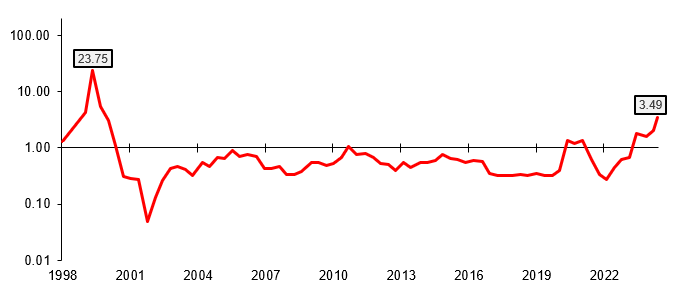Ever Heard of the Michael Saylor-Warren Buffett Ratio? It Just Did Something for the First Time Since 2000 and Could Trigger a Big Stock Market Move.
Aside from being multibillionaires, Berkshire Hathaway (NYSE: BRK.A)(NYSE: BRK.B) CEO Warren Buffett and MicroStrategy (NASDAQ: MSTR) CEO Michael Saylor don’t have too much in common. One is a traditional investor in his mid-90s while the other is in his late 50s and has branched out into newer investing ideas. Buffett has previously referred to Bitcoin (CRYPTO: BTC) as “rat poison squared,” while Saylor thinks the price of Bitcoin could reach $13 million by 2045.
However, a former Ivy League finance professor and portfolio manager thinks there could be a correlation between MicroStrategy’s and Berkshire’s stocks. He has coined this correlation the Saylor-Buffett ratio. Interestingly, the ratio is doing something it hasn’t done since 2000, which could trigger a big move for the stock market.
Are You Missing The Morning Scoop? Wake up with Breakfast news in your inbox every market day. Sign Up For Free »
Owen Lamont, a portfolio manager at Acadian Asset Management, created the Saylor-Buffett ratio and recently discussed the concept in a blog post. Lamont has been using the ratio to monitor fear and greed in the market.
Sentiment is an important factor in determining what the market might do next. While many believe in efficient markets (and many others don’t), markets are rarely efficient when one might expect and sentiment can be a reason. If investors are enthusiastic about stocks it will likely take some time for the whole market to settle down even if the market is overvalued. The same concept applies when markets are struggling — valuations might be attractive, but investor sentiment is negative and risk-averse.
Lamont considers Buffett and Berkshire to represent more traditional companies in the market, which makes sense considering Berkshire operates insurance, mortgage, railroad, and energy businesses. Saylor is on the other end of the spectrum with a high-octane growth mindset. The Saylor-Buffett ratio looks at the total cumulative return of MicroStrategy’s stock divided by the total cumulative return of Berkshire’s Class B shares. Lamont acknowledges that he made up the ratio and that it’s not a “scientifically valid measure derived from first principles.”
When the ratio is high, MicroStrategy’s stock outperforms Berkshire’s. This reflects investor exuberance in riskier assets and greed, and likely means the market is overvalued or getting frothy. Lamont found the ratio peaked at 18 in February 2000 right before the dot-com crash the following month. The Saylor-Buffett ratio spent most of the next two decades below 1, meaning investor exuberance settled down and favored subtle, proven long-term investing, a trend Buffett and Berkshire have embodied for decades. However, the ratio started to make waves in 2020 around the time the meme-stock craze hit the market. I have recreated Lamont’s chart below. The numbers are not exact, but they plot a very similar trend to his graph.



Leave a Reply